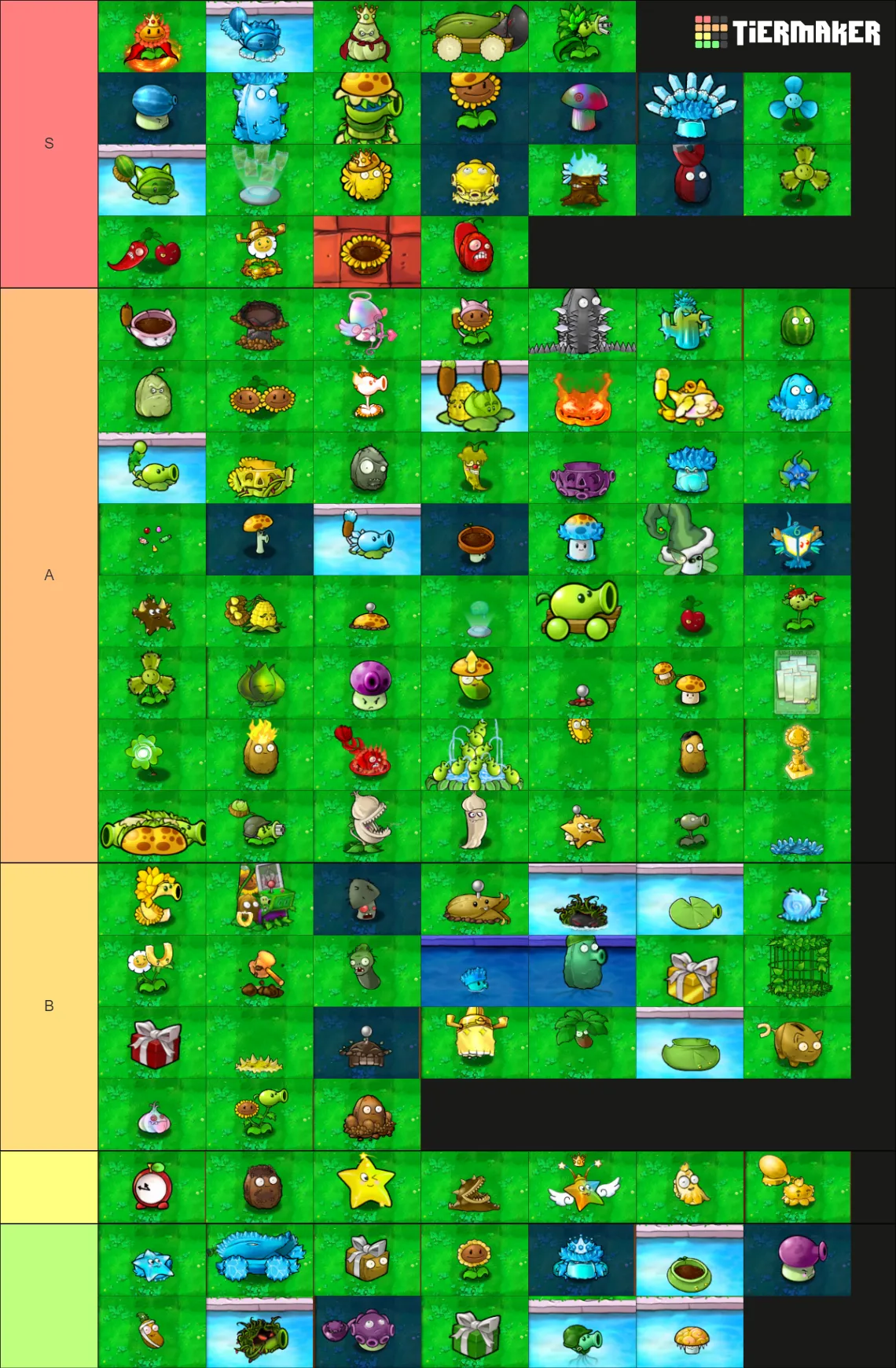In Plants vs. Zombies Hybrid Edition, the introduction of hybrid plants has completely transformed the gameplay, making plant selection more complex and strategic than ever. Players need to choose their plants wisely based on various factors such as their abilities, overall strength, and how they fit into their broader strategy. This guide will provide a detailed breakdown of the PVZ Hybrid Edition Plants Tier List, helping you understand why each plant is ranked in its respective tier, what each tier signifies, and how you can use this information to enhance your gameplay.
Best Plants of PVZ Hybrid Last Version
Understanding the Tier List
A tier list ranks items (in this case, plants) based on their performance, utility, and power level within the game. In PVZ Hybrid Edition, plants are divided into three tiers: S, A, and B.
S Tier: These plants are considered the most powerful and versatile. They excel in multiple roles, often combining high offensive and defensive capabilities, and are invaluable in nearly every situation.
A Tier: These plants are strong and useful, but they may lack some of the flexibility or game-changing power of the S-tier plants. They can still be critical in many strategies, but they require more specific use cases or support to be at their best.
B Tier: B-tier plants are generally more niche or situational. They may shine in specific scenarios, but overall, they are less impactful than A- or S-tier plants. These plants often require careful placement or timing to be effective.
S-Tier Plants: The Best of the Best
Plants in the S Tier are the most reliable and powerful in the game. These hybrids tend to be versatile, strong, and useful in nearly every battle, making them core choices for any lineup.
Notable S-Tier Plants:
Sun God (Hybrid Sunflower): This plant is crucial for generating sun while also being able to deal offensive damage. The combination of resource production and attacking capabilities makes it a must-have for long battles.
Ice Shroom (Freeze Master): This hybrid can freeze large areas, stopping zombie waves in their tracks. Freezing is one of the most powerful crowd control abilities in the game, and when combined with offensive power, this plant is a game-changer.
Cherry Bomb Hybrid: With the classic ability to cause explosive damage in a large radius, the hybrid version of Cherry Bomb adds even more destructive power, making it indispensable when you’re overwhelmed by zombies.
Knight Tree: The perfect defensive barrier, this hybrid tree is armored to absorb damage, protecting other more fragile plants. Its durability makes it an S-tier option for tanking zombie hits.
Exploding Seed Tree: This plant detonates upon being attacked, dealing significant area-of-effect damage and stunning enemies. It serves both as a defensive and offensive unit, earning its spot in the S tier.
A-Tier Plants: Solid, but with Limitations
A-tier plants are strong and useful but may lack the all-around versatility or sheer power of S-tier plants. They often excel in specific situations but may need more support to fully realize their potential.
Notable A-Tier Plants:
Twin Sunflower (Sun Generator): While not as versatile as its hybrid counterpart in the S tier, Twin Sunflower is still an essential plant for generating sun quickly. It’s great for early game setups where resources are tight.
Cactus Hybrid: This plant offers a combination of both offense and defense, with spikes that can shoot zombies at a distance while also protecting nearby plants. However, it is more situational than some other hybrids, which is why it ranks lower.
Fire Peashooter Hybrid: Dealing fire damage to multiple zombies, this plant is fantastic for early and mid-game situations. However, it lacks the complexity or additional abilities of other top-tier plants, which limits its utility in later stages.
Cabbage-pult Hybrid: This plant is fantastic for dealing damage to zombies on rooftops or other hard-to-reach areas, but its limited range of use and slower rate of fire place it in the A tier.
Venomous Plant: This plant deals damage over time with its poisonous thorns, making it useful for weakening stronger zombies. However, its reliance on long-term damage rather than burst damage limits its immediate effectiveness, relegating it to the A tier.
B-Tier Plants: Situational and Niche
B-tier plants are generally less powerful or useful than those in the higher tiers. While they may be valuable in certain situations, they lack the flexibility or impact of A- or S-tier plants.
Notable B-Tier Plants:
Lilypad Hybrid: This plant allows other plants to be placed on water, which is useful in specific water levels. However, its utility is highly situational, as it provides no direct offensive or defensive abilities on its own.
Garlic Hybrid: Garlic forces zombies to change lanes, which can be useful for redirecting zombie traffic. However, this is a niche ability that works best in very specific strategies, limiting its overall utility.
Pumpkin Hybrid: This plant acts as a protective shell for others, absorbing damage. While useful for shielding weaker plants, its lack of offensive power and reliance on other plants to be effective reduce its ranking.
Magnet-shroom Hybrid: While its ability to remove metal objects from zombies is useful in some levels, it’s highly situational and not as broadly effective as other crowd-control plants.
Coconut Cannon Hybrid: While capable of dealing large amounts of damage in a straight line, the Coconut Cannon’s slow reload time and expensive cost place it in the B tier.
How to Use the Tier List in Your Strategy
Focus on S-Tier Plants: Prioritize unlocking and using S-tier plants in your strategy. These plants will be the core of your defense and offense due to their unmatched versatility and strength.
Support with A-Tier Plants: Use A-tier plants to fill in gaps where S-tier plants might not be as effective. For example, if you need more sun generation early on, use the Twin Sunflower hybrid, or if you’re facing specific types of zombies, consider the Cabbage-pult hybrid.
Niche Situations Call for B-Tier Plants: While B-tier plants may not be the most powerful, they can still be useful in specific situations. For example, Lilypad hybrids are essential in water-based levels, and Garlic hybrids can work well in redirecting zombies during survival mode.
Adapt to New Challenges: As you progress through PVZ Hybrid Edition, the complexity of the game increases. The higher-tier zombies will require smarter plant combinations, and relying solely on S-tier plants may not always be enough. Use A- and B-tier plants to supplement your defense in challenging levels.
The Plants Tier List in Plants vs. Zombies Hybrid Edition offers a clear insight into the best and most effective plants in the game. By understanding which plants are S, A, or B tier, you can better strategize and optimize your defenses to defeat waves of zombies with ease.







